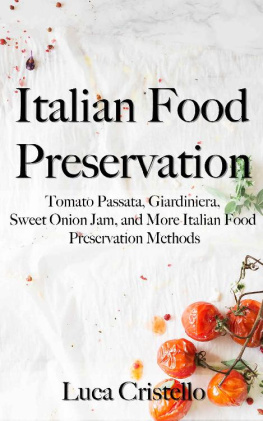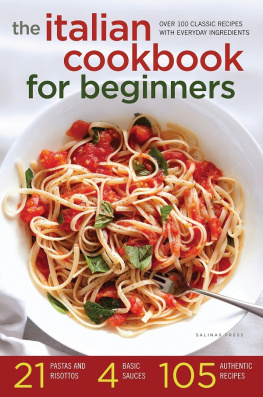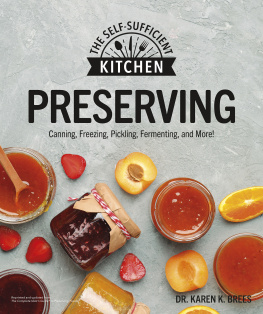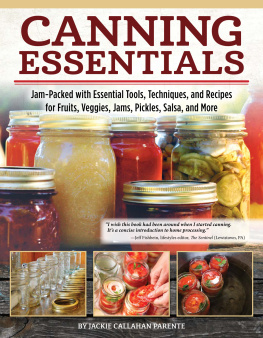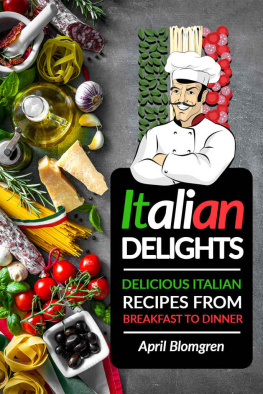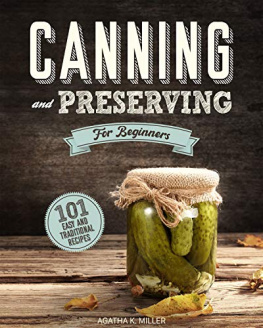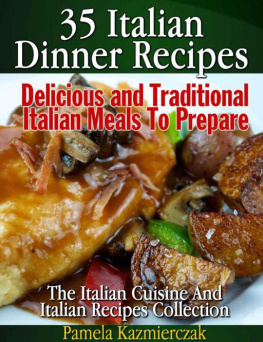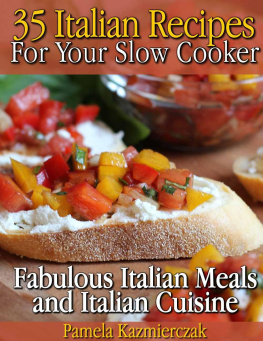Italian Food Preservation:
Tomato Passata, Giardiniera, Sweet Onion Jam, and More Italian Food Preservation Methods
Luca Cristello
Italian Food Preservation: Tomato Passata, Giardiniera, Sweet Onion Jam, and More Italian Food Preservation Methods
Published by Eburnean Books
2018 Emberworks Creative, LLC
All rights reserved.
www.emberworkscreative.com
For information on new book releases and giveaways, join our newsletter .
Table of Contents
Introduction
Since ancient times, mankind has always needed to preserve food as long as possible to have supplies for the winter or to face times of famine. The Romans kept food in rudimentary iceboxes, caves that had been filled with ice and snow in the winter.
Then, in the 1800s, the French cook Nicolas Appert noticed that foods placed in glass jars with long necks, cooked, and then sealed with cork fixed with iron wires lasted longer. He thus invented canned preservation, a method still widely used today by both industry professionals and at home cooks.
Generally, food can deteriorate in two ways: through biological causes and through chemical-physical causes.
Micro-organisms, parasites (such as bacteria, insects and rodents), and enzymes naturally contained in food are all possible causes of biological deterioration. Chemical-physical deterioration can instead depend on factors such as oxygen, light, temperature, humidity, dehydration and mechanical stress.
In order to avoid health risks, it is necessary to eliminate the potential causes of alteration of the foods we consume, and in this way we prolong their duration.
Its easiest to avoid the development of microorganisms if there are no traces of contamination on food prior to preservation. This result is obtained by means of sterilization or pasteurization, one of the most classic italian methods of food preservation.
Sterilization happens when we heat food at high temperatures (over 100 C or 212 F for at least 20 minutes) Pasteurization happens by heating food at temperatures below 100 C or 212 for variable time periods.
We can also preserve food by making its environment hostile to mold and bacteria by removing oxygen, enriching it with salt or sugar, or making it very acidic. Preserves in oil, pickled food, salted food, jams and canned syrups are all examples of environments that are hostile to micro-organisms and that Italian cooks use most often.
The simplest and most classic Italian method to preserve food is to extract water from a food or sterilize water in a food, prohibiting mold and bacteria from developing. This is achieved by exposing food to the sun, using a ventilated oven, or freezing.

Le Conserve
Italians call their dishes of preserved food conserve . They use several methods of preservation to counteract unwanted contamination. One method of preservation may have its own weaknesses. By using more than one type of defense, food deteriorates less.
SottOlio
An Italian example of this multi step preservation is the preservation in oil or sottolio . This widespread preservation technique is designed to isolate food from contact with air.
In this way the proliferation of aerobic bacteria (microogranisms that foods develop from contribution of oxygen) is inhibited.
However, oil alone does not inhibit the development of anaerobic bacteria, including the famous botulinum, a bacterium that produces toxins that are particularly dangerous and poisonous to our body. In addition, the oil, opposed to salt and sugar, has no direct action on the water present in food, where bacteria develops.
Therefore, this technique is always associated with other methods of food preservation.
Foods in oil are often put through a transformation process via cooking or salting, and then sterilized with the high temperatures. Additionally, these techniques are often associated with refrigerationat home, it is done simply by storing our foods in the refrigerator.
In sottolio , it is extremely important that the food be completely immersed in the oil, to avoid air coming in contact with some part of the food, making the previous antibacterial processes ineffective. Even the air bubbles that can form inside the jars of food sottolio could be harmful. This is why it is unwise to consume products that are found inside unsealed containers.
Preserving foods sottolio is particularly common in Italy as an at-home method to preserve vegetables or fruit for a long time. The food, previously cooked, is immersed in the oil in order to create an oxygen-free environment. It is necessary to use perfectly clean jars and close them tightly to proceed with the sterilization phase, in which the jars are wrapped in rags and immersed in boiling water.
The great advantage of food sottolio is the ability to have the products available throughout the year. It offers a clear economic advantage because you dont have to buy produce out of season when these foods cost more.
On the other hand, food preserved sottolio has a couple of drawbacks. The food may lose nutrients and vitamins through the preservation process. Being immersed in oil yields a high fat content. In fact, although the product can be drained from its preservation oil, it assimilates and absorbs a lot. For example, vegetables sottolio may have a fat content of about 10 times higher than the fresh products!
Preservation sottolio is typical of vegetables such as artichokes, mushrooms, peas, peppers, eggplants, olives etc; but it is also used for some fish. You likely have some tuna fish sottolio in your pantry right now.
A final note, if you use a good olive oil, the end product will always taste better.
Chemical Preservation
You can preserve food by adding chemicals to the food, essentially killing bacteria or creating anaerobic environments. When we say chemical, we dont necessarily mean artificial preservatives. Chemicals could be natural substances that simply have a chemical effect in preserving food.
Salt, for this purpose, is a chemical substance, as is sugar. Even oil is a chemical substance (a fat), and since it does not mix with water, it prevents bacteria from breathing. Editors Note: Again, beware that oil alone does not prevent anaerobic contamination. When preparing foods sottolio always combine preservation methods.
Among the chemicals, we have alcohol and vinegar, which completely destroy bacteria.
These products alter the taste of food and, in some cases, even the chemical content, but because they are chemical substances that actively destroy bacteria, they are among the best preservation methods. Some natural substances, such as the acid present in tomatoes or those present in lemon (citric acid), have the same effect. They kill bacteria directly, effectively functioning as disinfectants.
Of course, storage with chemicals also includes a category of additives which are preservatives, generally synthetic (apart from citric acid). These substances do not alter the taste of food, but they have an active effect on the bacteria and they dont alter the substances naturally present in food. Because of these benefits, most food industry professionals producing preserved food use these types of chemical substances.
Fermentation
Finally, fermentation is a preservation method in which bacteria are not killed directly, but they push themselves to self destruction. An example is salami, yogurt, wine and beer.
When it comes to altering the original substance of a food, this is arguably the most invasive method of preservation.
In brief, fuel is offered up to bacteria or fungi in a food. They take advantage of this substance, usually sugar, to create another substance, often lactic acid. In the case of beer or wine, they create alcohol. This reaction continues until the alcohol or the lactic acid completely overwhelms the bacteria or fungi, killing it off.
Next page
